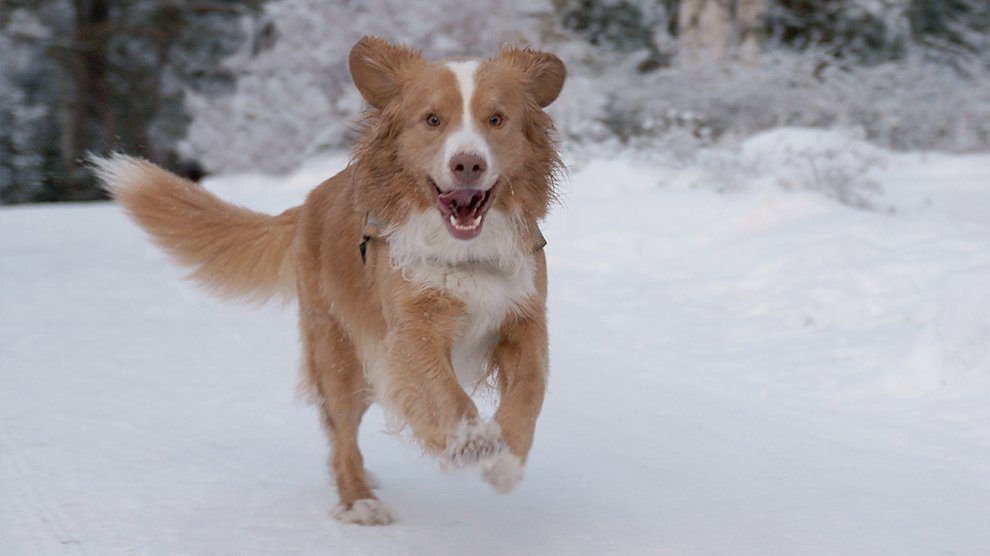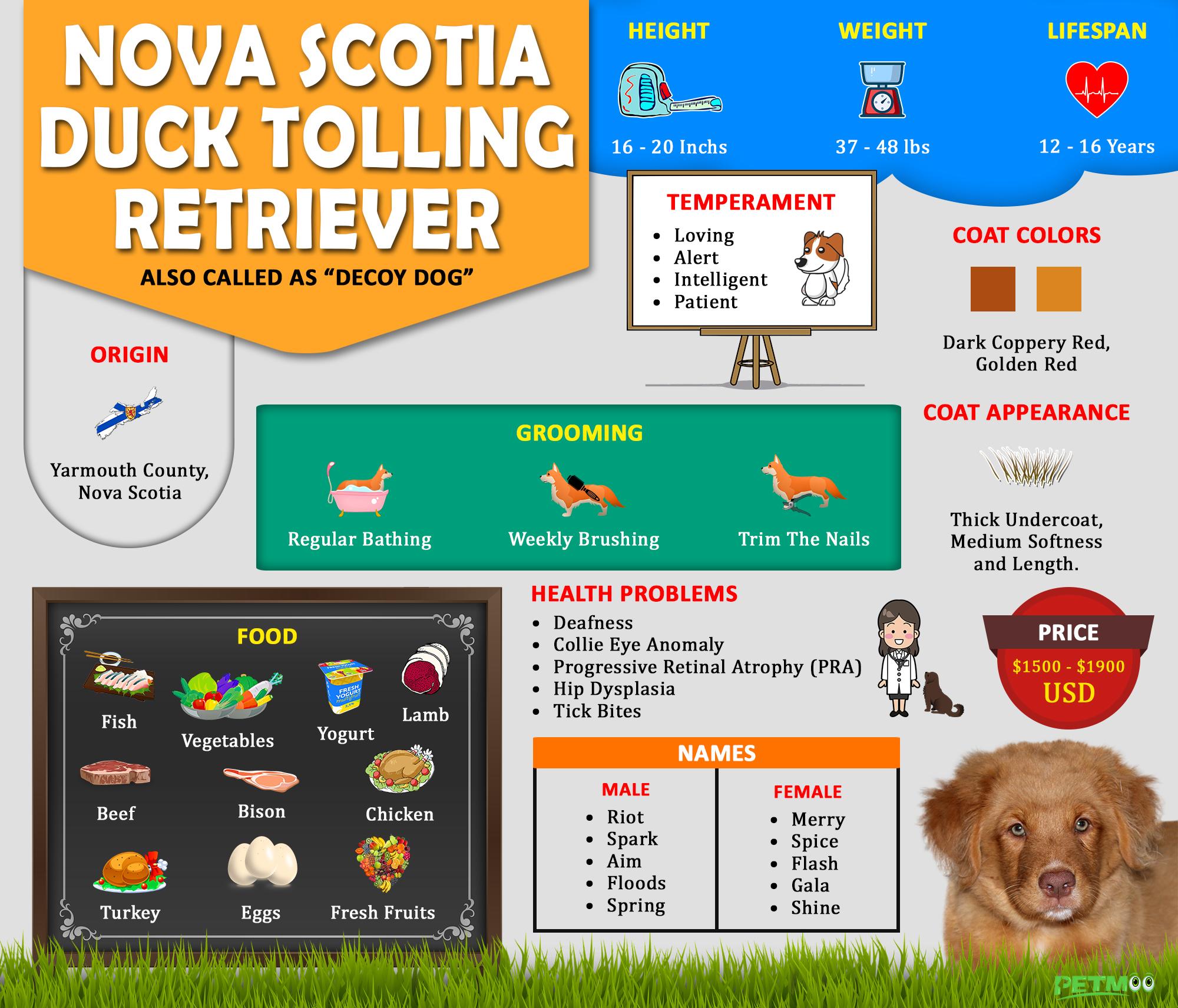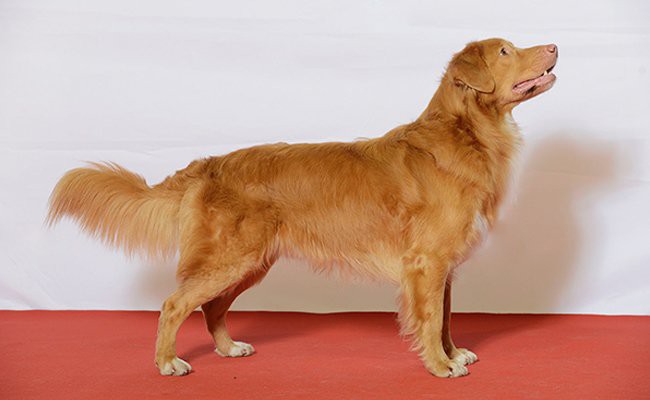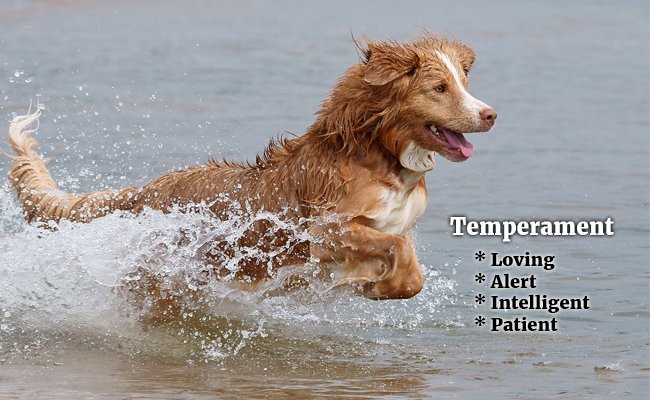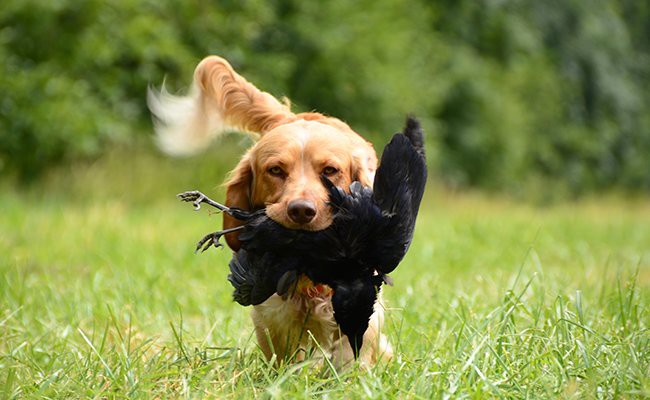Dog Pregnancy Calculator And Timeline
One of the cutest but smallest AKC member, Nova Scotia Duck Tolling Retriever is around 45 cms to 48 cms.
Want to know the best part?
Very agile and strong, Tollers are strong medium sized dogs- they are medium in coat dimension, bone, and size. However, their soul-penetrating almond eyes always express an active expression.
In fact, Tollers are tireless athletes who are ready to venture out and take part in activities such as swimming, camping, hiking, and hunting.
Overall, Nova Scotia Duck Tolling Retrievers are ideal for those who can share energy and interest and help them keep busy.
Nova Scotia Duck Tolling Retriever History
Also called as “Decoy Dog”, Tollers are medium-sized energetic breed which originated from the Yarmouth County located in Nova Scotia.
Moreover, Tollers were bred to hunt in an unusual manner. In general, these dogs mimic the movement of a fox which induces the waterfowl to venture out.
Also, the dog’s appearance looks like a fox to the innocent ducks. Then, when the bird enters the gunshot range, they are hunted.
Other than Tollers, only Dutch Decoy Spaniel specializes and hunts in this method. In 2003, Tollers received the recognition of AKC, thereby becoming the only breed that has more than 35 spaces in their name.
Toller Dog Facts
Nova Scotia Duck Tolling Retriever Appearance
Stamped as the smallest from the retriever family, they are well-balanced, compact, and powerful medium sized. Also, this wonderful dog’s bearing and personality reflect agility and high amount of energy.
Besides that, Tollers move quickly and are always determined and smart with an enthusiastic ability to please and work.
However, these dogs at times show or exhibit a slightly worried expression. The second they sense an opportunity for retrieving, they immediately jump into action expressing excitement and focus.
To conclude, Tollers keep their tails high while retrieving or engaging in any activity.
Nova Scotia Duck Tolling Retriever Coat
In fact, this breed was created to retrieve things from cold waters and they should possess a water-proof coat of medium softness and length.
Additionally, Tollers also have a thick undercoat. Meanwhile, the coat is usually straight and may feature a wave-like an appearance. Featherings are very moderate in length and soft by nature.
For instance, the muzzle contains very fine and short hair. Also, these dogs shed occasionally.
Finally, for show rings, the neatening of hocks, ears, and feet is allowed but they should never appear barbered or appear unnatural.
Nova Scotia Duck Tolling Retriever Colors
Tollers normally appear in red colour, from dark coppery red to golden red with very less feathering. On the other hand, light shades are often witnessed with deep pigmentation.
However, black markings in buff or coat are considered as a deviation. Tollers contain white markings in blaze, chest, and feet and also on tail tips.
In conclusion, a dog should never be penalized in case they appear without white markings.
Nova Scotia Duck Tolling Retriever Grooming
First of all, Tollers definitely need weekly brushing and during the shedding period, there are no second thoughts.
Not to mention, the most important area that needs more attention is under the ears and coat. Remember, these dogs should remain natural, only necessary additional grooming is allowed.
Generally speaking, take care and remove extra hair between feet pads and trim the nails at least once a week.
Nova Scotia Duck Tolling Retriever Size
Males are between 45 cms to 53 cms inches in height and females, 43 cms to 50 cms tall. Male and female Nova Scotia Duck Tolling Retriever weighs around 20 kgs to 22 kgs and 17 kgs to 19 kgs respectively.
Nova Scotia Duck Tolling Retriever Lifespan
Tollers have a life expectancy of between 12-16 years.
Nova Scotia Duck Tolling Retriever Temperament
- Tollers are known and appreciated for their independent, astute, and curious humorous nature.
- Moreover, they are highly sensitive, good with children, and easy to train. And, Tollers are best when they have enough work or activity to handle.
- Of course, these dogs are less adaptable to new persons or strangers than Golden Retrievers. Therefore, early socialization holds the key.
- Toller dogs love retrieving games and are ideal for first timers too. Why? Their eagerness to please and their smart thinking abilities make them very easy to handle and train.
- In addition, they do not possess super strong prey drive. But, Tollers do chase smaller animals like a cat when they are in the mood.
- Not to mention, these dogs carry a tremendous percentage of stamina and are most suited for people who always roam outside.
- Separation anxiety takes a toll on Tollers as they like to stay in households where they receive better attention and be happy. Tollers do not like to be left alone for a long duration.
- Being exceptional swimmers, tollers love water and its surroundings. However, if you are not careful, they may get into trouble.
- Overall, they are not like Bullmastiff or Puli, Tollers were never been popular as guard dogs.
Nova Scotia Duck Tolling Retriever Screaming
Generally, Toller’s screaming indicates eagerness and excitement. Not all but many tollers scream, which sounds like dog fed into the wood chipper.
High pitched, loud and frantic screaming noise will be annoying to most of us. Also, they are known as toller scream.
This screaming dog is not suitable for persons who get in trouble due to dogs noise. If you are getting a nova scotia duck tolling retriever as a pet then you should teach them quiet manners.
Nova Scotia Duck Tolling Retriever Training
Personality-wise, Tollers look soft but carry some bundle of stubbornness. In addition, these dogs have the Spaniel’s big heart and Chessie’s brain power.
Above all, Toller’s love reward or incentive-based training. In fact, they are eager to know what they will gain from the training. Therefore, short reward-based training is best to produce the maximum result.
Exercise
Are you aware?
Most Tollers posses’ high to mid-level energy and they are not satisfied until they engage in some kind of activity on a day to day basis. For example, ball chasing activities coupled with 30-minute brisk walk will satisfy most Tollers.
Not to mention, Tollers like to spend time and participate in various canine sports including fieldwork, flyball, or agility. To sum up, taking part in these kinds of activities gradually strengthens the relationship between Toller and owner.
Nova Scotia Duck Tolling Retriever Food
Things to keep in mind:
On a daily basis, Tollers require 2.5 – 3 bowls of food, divided into different parts, preferably 2 meals a day.
Some of the recommended dog foods are fish, lamb, venison, bison, beef, turkey, and real chicken. Also, feed your dog with a good amount of fresh fruits, vegetables, eggs, and yoghurt.
Finally, fresh foods are recommended by the vets.
- The dog’s structure, age, activity level, metabolism, and overall built must be taken into consideration before deciding on their intake.
- Learn to perform a hands-on test to examine whether the dog is obese or not. Place your hands on the dog’s body, along with the spine and thumb in line with fingers pointing towards the ground. If you can feel the ribs, then the dog is in shape else check his diet.
To make sure that your Toller is in sound health, check his food intake on a daily basis.
Must Read: What Foods Can/Cannot Dogs Eat?
Nova Scotia Duck Tolling Retriever Interesting Facts
It gets better:
- Mainly appreciated for their decoy skills in hunting down waterfowls, Tollers use their fluttering tails and skilful intelligence to draw the ducks outside their habitat.
- Called as “Little River Duck Dog”, Tollers were modelled on MicMac Indian Dog.
- Tollers tend to make a shrieking scream when they are excited and happy to please. Moreover, people living in apartments and small houses might give Nova Scotia Duck Tolling Retriever a miss.
- Affectionately known as a “retrieving fool”, these working dogs carry a never-ending drive to fetch things that will continue even if your hand falls off.
- World’s best enthusiastic dog! They always explode with complete energy and life.
Nova Scotia Duck Tolling Retriever Names
Check this out:
The names on the list celebrate and highlights the Tollers attributes, energy, enthusiasm, and charm.
| Female Toller Name | Male Toller Names |
|---|---|
| Tempt | Swag |
| Snap | Plot |
| Run | Riot |
| Merry | Joker |
| Kindle | Guns |
| Spice | Spark |
| Flash | Aim |
| Gala | Floods |
| Winter | Bash |
| Shine | Spring |
Nova Scotia Duck Tolling Retriever Price
Now:
Are you available?
The Toller puppies are priced based on different factors such as early socialization, ancestry, litter size, breeder reputation, and so on. Getting back to business, Toller puppies are sold between USD $ 1500 to USD $ 1900.
For this price, you can expect to buy a Toller without documents. But, if you are ready to pay a premium for superior Toller puppies, be prepared to shell USD $ 2200 to USD $ 5000.
Also, keep in mind the other costs that includes toys, dental care, food, neuter fees, grooming, and much more. Set aside a little more than USD $ 500 to USD $ 2000 every year for these expenses.
Therefore, take a call and decide wisely before buying a Toller considering these things.
Nova Scotia Duck Tolling Retriever Breeders
- Red Shadow Kennels
Address:
Whitby, Ontario,
Canada - AKC Operations Center
Address:
8051 Arco Corporate Drive, Suite 100
Raleigh, NC 27617-3390 - AKC Headquarters
Address:
260 Madison Ave
New York, NY 10016
Nova Scotia Duck Tolling Retriever Health Problems
Under normal circumstances, Tollers are sound and healthy dog breeds. Some of the health issues are Addison’s disease which will mostly remain hidden until the dog has produced offspring.
Deafness
Although not all Tollers are affected by hearing loss, some Tollers suffer hearing loss by the time they reach 7 or 8 years.
Causes of Deafness
The main causes of deafness are further classified as acquired deafness and congenital deafness.
Congenital deafness refers to a state where the dog is born deaf because of genetic factors. Now, acquired deafness is caused due to geriatric nerve degeneration, ear canal block, infection, or trauma.
Main causes of acquired hearing loss
- Specific drugs can cause hearing loss in Tollers. They are cisplatin, furosemide, erythromycin, ethanol, and chlorhexidine etc.
- Eustachian tube tumour
- Inflammation
- Infection
- Injury to the eardrum etc.
- Old age issues like geriatric nerve degeneration
Causes of Congenital hearing loss
- Factors such as merle coats, ears, and white head are related to hearing loss
- Nervous system damage can also happen due to genetic inheritance
Symptoms of Deafness
Some of the signs of deafness
- Frequent barking
- Startled and looks puzzled after waking up
- Finding it difficult to wake up
- Remain aloof to sounds nearby
- Stays idle when the name is called
Treatment for Deafness
Surgery is the best option. However, geriatric or congenital hearing loss remains untreatable even with surgery.
Also, cochlear implants and hearing aids are not cheaper and dogs do not respond to it positively. In addition, vets may also opt for ear canal washing depending on the severity of the infection.
Collie Eye Anomaly
This type of problem is normally found in Collie dog breeds, and it can also affect Nova Scotia Duck Tolling Retriever. Leading to premature blindness at the age of 2 or so, it can be diagnosed by any qualified veterinary ophthalmologist.
This condition, unfortunately, does not have any treatment and the dog has to manage his senses to move around. The breeder must be immediately informed if the puppy is found with this condition.
Being a hereditary disease, it is well advised to neuter or spay the dog to prevent the disease from passing on to the next generation.
Causes of Collie Eye Anomaly
- The defect of chromosome 37 in dogs is one of the main reason
- A further defect in other chromosomes are not ruled out
Symptoms of Collie Eye Anomaly
- Presence of microphthalmia
- Existence of enophthalmia
- Anterior corneal stromal mineralization
- In certain cases, no signs of any abnormalities till the blindness actually sets in
Treatment for Collie Eye Anomaly
- There are no cures currently available for this But, other conditions like coloboma are treatable to a certain extent.
- Vets recommend laser surgery in certain cases.
- Alternatively, they may conduct cryosurgery where they use severe cold to repair retinal detachment.
Progressive Retinal Atrophy (PRA)

A degenerative eye problem, PRA can cause severe vision loss due to the loss of photoreceptors in the eye. Fortunately, it is possible to detect this problem long before the crisis actually affects the dog.
Respectable breeders will have the eyes of their dogs checked annually and verified by a qualified veterinary ophthalmologist. They do not breed the dogs diagnosed with this condition.
Causes of PRA
Different causes of PRA in dogs
- Being a genetic disease, PRA is a condition wherein the retina is damaged due to tissue degeneration.
- Autosomal recessive gene plays a crucial role in causing this condition in dogs.
- For instance, the puppies are still prone to PRA even if their parents remain unaffected.
- Also, PRA affects a dog when they are somewhere between 6 – 8 years.
Symptoms of PRA
The first and foremost symptom of PRA in dogs is night blindness. Other signs include
- Difficult to climb stairs
- Stumbling and falling over objects
- Constantly dashing into objects
- Presence of cataracts
- Eye turning grey in colour
Treatment for PRA
Unfortunately, there are no treatments or cures available. But, with minor lifestyle changes, many dogs can manage this disorder very effectively.
Finally, PRA generally results in vision loss in both the eyes and the condition is irreversible.
Hip dysplasia
In this case, the thighbone and hip joint does not gel or fit properly. Certain dogs will show pain and lameness while others might not exhibit any sort of pain or discomfort. With passing time, any dog can develop arthritis.
Scanning the dog for the symptoms of hip dysplasia can help to identify this problem early and take corrective measures without any delay.
It is a genetic problem; this can also be worsened due to other factors such as environmental conditions, injuries caused due to jumping on slick surfaces, and high-calorie intake etc.
Causes of Hip Dysplasia
As per medical reports, dogs as young as 16 weeks can still develop this condition. Next, geriatric dysplasia occurs due to joint cartilage degeneration or osteoarthritis.
Moreover, in dogs, both the joints are likely to get affected.
Main causes of hip dysplasia
- Lack of essential nutrition
- Injuries can also cause hip dysplasia
- Overweight or obesity due to lack of enough physical exercise or genetic factors
- Unnatural weight increase
- Breeds like Saint Bernard, Great Danes, and German Shepherd are also affected by this condition. In addition, even small dog breeds are also prone to genetic hip dysplasia.
Symptoms of Hip Dysplasia
The common sign of hip dysplasia depends on various factors such as disease duration, joint looseness, and joint inflammation.
- Severe pain in the hip joints
- Damage of muscle mass in the hind legs
- Unnatural closeness between hind legs
- Limited hip motion
- Hopping
- Climbing stairs
- Trouble getting up
- Lameness in the hind legs
- Lack of vigorous activity
Treatment for Hip Dysplasia
Some of the available treatment options for hip dysplasia
- Surgery – In short, surgery is recommended based on several factors such as the amount of degeneration, laxity, activity level, size, and age.
- Juvenile Public Sympyhsiodesis – This surgery is performed even before the dog reaches 3 months of age. In this surgery, the vet fuses the pelvic bones thereby saving the dog from osteoarthritis.
- Excision arthroplasty – The vet replaces the femur head with an implant. However, excision arthroplasty is mainly suitable for dogs that weigh less, not more than 40 lbs. Furthermore, this treatment costs much less than complete hip replacement.
- Complete hip replacement – Mainly carried out on dogs suffering from chronic hip dysplasia where an implant replaces the hip joint.
- TPO (Triple Pelvic Osteotomy) – TPO performed on dogs less than 10 months of age carries a higher percentage of success. This surgery suits dogs that suffer from severe joint looseness.
- Drugs – Drugs such as NSAIDS or anti-inflammatory drugs reduces inflammation and pain. On the contrary, these drugs are not safe for long-term use and can cause serious side effects.
- Physiotherapy – Physiotherapy improves muscle mass and swimming is one of the low-cost physiotherapy exercises for dogs.
- Oral medications – Vets advise supplements like Chondroitin and Glucosamine to help in managing the joints. In particular, oral medications can take six weeks or more to show impact.
- Weight and diet management – Without proper diet and weight management, the treatment for hip dysplasia may take time.
In general, you should give fast-growing and large breeds the correct and proper nutrition to reduce muscle-joint problems.
Overall, vets will recommend exercise and weight management based on your dog’s condition, breed, and age.
Tick Bites
The best practice involves frequent brushing. Be alerts and always check for ticks and fleas during warm season regularly.
Notably, Nova Scotia’s require very less bathing sessions and ideally not more than a couple of times in a year.
Simple tips include cutting and combing all mats and completely wash off the soap from their coat to prevent dust formation.
See Also: Tick Bite Fever

